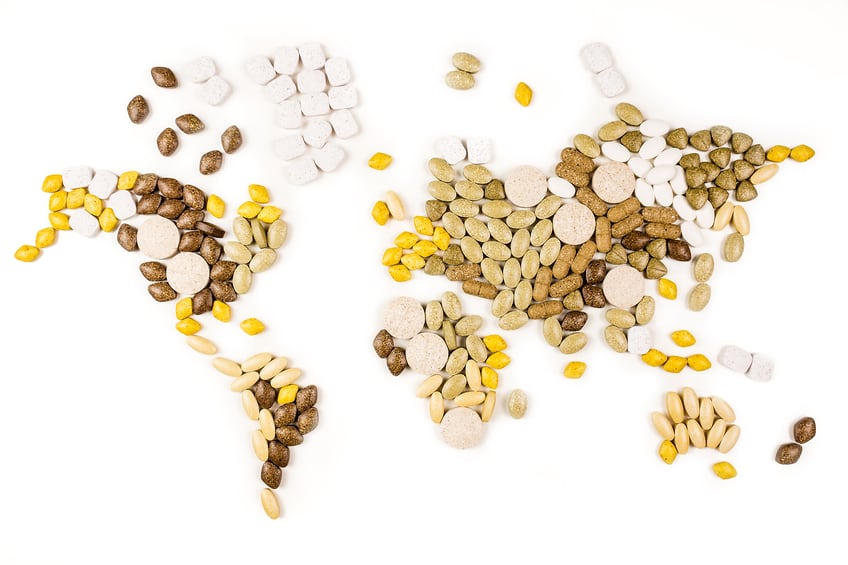Speaking to NutraIngredients, chief marketing officer of the Swiss-based operation, Stefan Schmidinger noted the market has stabilised after a couple of topsy turvy years.
Compared to very volatile markets in 2017 and 2018 due to environmental inspections and industry park closures in China, he says 2019 has been 'quite predictable' for many raw materials apart from a series of large accidents in chemical manufacturers late March.
“As some incumbent and new players continuously expand production capacity and demand has been affected by tariffs and fears of a recession, many ingredients trade at favourable low levels for buyers. Other factors include accidents or maintenance in large Chinese or German production sites.”
“In the overall market there are typically tactical situations where certain ingredients or input materials become scarce and prices move a lot.”
So what are the big movers up or down?
“For Kemiex vitamins, amino acids and additives for food and feed use,” he said. “In the vitamins space certainly calcium pantothenate, folic acid, vitamin K3 (Menadione Sodium Bisulfite (MSB)) and Nicotinamide (vitamin B3) experienced price increases over the past 12 months.”
“Those falling include vitamin B12 which has dropped 50% since December but could any time rise again. Moreover, vitamin C is seeing historically low prices after very volatile years in 2017 and 2018, sometimes trading below production cost. In the last 12 months we’ve also seen vitamin D3, vitamin B1 mono, vitamin B2, vitamin B6 decrease in price.”
“We expect new purchase contracts for fourth quarter 2019 and first half 2020 being closed in the coming weeks or at CPhI Frankfurt and Food Ingredients Europe, VIV and other industry fairs. Sometimes we see manufacturers cutting supply ahead of the fairs to support price negotiations.”
How much variance exists in the quality of ingredients?
“In general food and feed grade raw materials are of quite comparable quality, and the producers are often the same, but prices for pharma are higher than food which are higher than feed.
“Prices often move in parallel for different grades, but mostly depends on dosage form, production process, costs related to meet regulatory requirements, as well as market forces such as production capacity and demand. Not every producer has capabilities to produce pharma grade, but only food/feed. Markets such as the US, European Union, Russia or Brazil typically have the highest regulatory requirements and not all foreign products or manufacturers can be accepted.”
Regionally speaking, are there countries that dominate nutrient supply?
“Most of the manufacturing today happens in China and for pharmaceuticals also in India. Even established European manufacturers were forced to outsource part of their production away from Western Europe in the last decade to compete with vast new capacity brought to the global market by Chinese companies, as well as to supply these strongly growing Asian markets.”
“In Europe there exist hundreds of distributors, often based in Germany, Benelux and Spain, which serve end users as reliable and local counterparties, helping them to import foreign raw materials into the European Union, Russia or South and North America.”
“Recessionary tendencies show lower demand: for instance the German chemicals and pharma sector is expected to sell -6% in 2019.”
How have European companies dealt with the shift in supply toward China and Asia?
“China is dominant in producing commoditised raw materials, as production and local consumption is growing strongly. However, in the wake of trade wars and fragile global supply chains, some voices call for a return of production to Europe and the US to diversify for supply risks. Currently we continue to see more capacity growth in China, partially also for strongly growing local consumption and availability of cheap financing.
“Many Western producers shifted their focus over the years into high-value, advisory, formulation services and innovative new products and solutions, away from commodity trading.
“Buyers and traders in such volatile, fragmented and opaque markets are seeking strategic insights that support their commercial decision making.”
What events in China have most affected the market?
“The Chinese government since 2017 took a very hard stance to improve environmental and work safety, ground water contamination and carbon dioxide emissions, so markets were nervous and volatile in previous years.”
“Markets overreact irrationally to such events, for instance many antibiotics and vitamins rose in price after a series of Mid-March and April 2019 accidents at producers like Tianjiayi Chemicals, Jiangsu Zhongdan Chemical, Tianhe Pharma and Dongxing Chemical. The market reacted with panic and players take profits.”
“Companies like NHU, Shandong Luwei, Northeast Pharmaceutical or Anhui Tiger and others have been expanding output.”
What does a digital exchange like Kemiex offer the industry?
Kemies aims to solve some of the biggest challenges in chemicals purchasing especially in tight markets:
- Getting the right product – product availability with quality and specification controls.
- Getting it efficiently and conveniently without travel, dozens of calls, and beyond known sources.
- Getting it at the right price.”
“Kemiex has seen bulk raw materials valued at €125min the first half of 2019 offered through our network and platform, with spot deals ranging from €10,000 to €2m.”
“We perform financial checks through our strategic alliance partner Atradius credit insurance and perform a quality assessment through a standardised Quality Management System developed by our partner and seasoned quality consultant for major pharma companies, Dr. André Rieks.”

